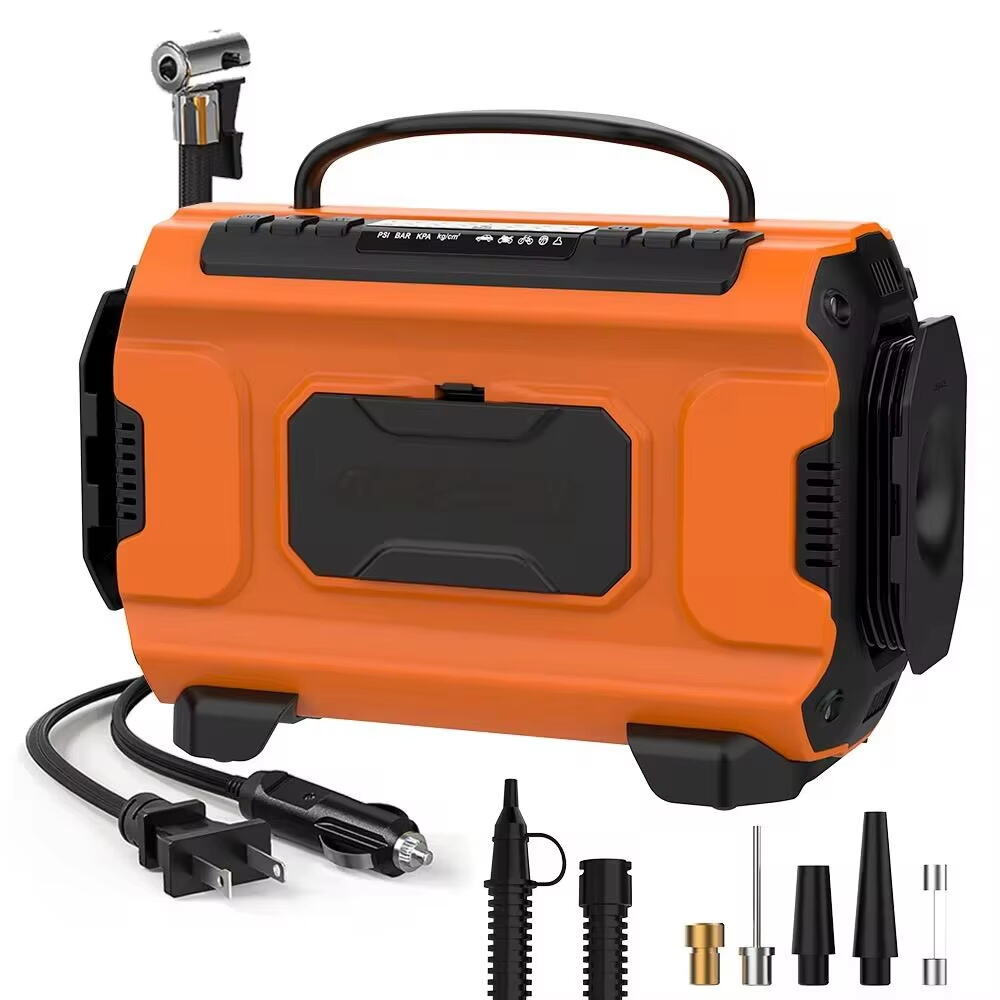What is a Car Air Compressor?
Definition and Primary Purpose
Car air compressors are pretty important gadgets that pump up air pressure. They get used for filling tires, powering those little pneumatic tools people have lying around garages, and keeping air conditioning systems running smoothly. What most folks really care about though is making sure their tires stay at the right pressure level. Proper tire inflation matters a lot for safety on the road, how the car handles corners, and even affects how much gas gets burned during drives. People who check their tire pressure regularly tend to notice better performance from their vehicles overall. Studies show that keeping tires properly inflated can actually boost gas mileage somewhere around 3%. That might not seem like much, but over thousands of miles driven each year, those small improvements add up to real money saved at the pump. Plus, when cars run more efficiently, they naturally produce fewer emissions too.
Key Components of a Car Air Compressor
When talking about what makes up a good car air compressor, we're looking at several key parts working together: motor, pump, air tank, pressure gauge, and regulator. The motor basically powers everything else, driving the pump that actually does the job of squeezing air down and sending it into the tank where it gets stored. Most tanks are made from durable steel and can hold anywhere from 5 to 10 gallons depending on size. Keeping track of pressure is essential too, which is why most units come equipped with a pressure gauge. This lets users know when things might be getting too high or low, preventing damage to both equipment and tires. Then there's the regulator part, which acts as kind of a traffic cop for airflow, making sure pressure stays just right whether someone needs to inflate bicycle tires or fill up truck wheels. All these pieces need to play nicely together so the whole system works properly, giving drivers access to dependable compressed air whenever they need it for all sorts of tasks around the vehicle.
How Does a Car Air Compressor Work?
The Compression Process Explained
When a car air compressor gets going, it all starts with turning on the motor that powers the pump. Air flows into the system through an intake valve first, then gets squeezed down inside before moving into the storage tank. Most compressors work by either pushing air down with pistons or spinning it around with something called a rotary screw. Either way, these mechanisms shrink the space the air takes up, which makes the pressure build up pretty quickly. After this compression happens, the tank fills with pressurized air waiting to be used for things like filling tires back up to spec or running those little pneumatic tools mechanics love so much.
Role in the Air Conditioning System
The compressor plays a key role in a car's air conditioning setup, basically moving refrigerant around while keeping things pressurized properly. What happens here is pretty straightforward really – the compressor takes that low pressure gas and squishes it into something much higher pressure, so it flows better through all those coils in the condenser and evaporator parts. During those sweltering summer days when everyone wants ice cold air blowing on their face, this whole compression thing becomes super important for actually making the cabin cool down. When compressors start acting up though, people notice right away because the AC just doesn't work as well anymore. That's why checking on them regularly makes sense if drivers want their cars to stay comfortable no matter what kind of heat wave hits outside.
Connection to Tire Inflation
Car air compressors play a key role in tire inflation systems, offering drivers a fast way to adjust their tire pressures when needed. Nearly all models come with straightforward attachments for regular tire valves, so keeping tires properly inflated isn't as complicated as people think. When tires are filled correctly, they not only make driving safer but also help save money at the gas pump while extending how long tires last before needing replacement. According to recent studies, almost half of all cars on American roads have tires that are either under or over inflated. This means millions of drivers could benefit from having access to a good quality air compressor, both for their own safety and to avoid unnecessary expenses down the road.
Types of Car Air Compressors
Portable vs. Built-In Models
Air compressors for cars basically fall into two main types these days: ones you can carry around and those that live inside the vehicle. The portable kind is great because they're small enough to toss in a trunk or glove box. People love them for quick tire inflation jobs or powering little tools when away from home workshops. Some folks even take theirs camping or fishing where having compressed air comes in handy beyond just car maintenance. Built in compressors work differently since manufacturers install them directly into newer vehicles. They give drivers instant access without needing to hunt for equipment, but obviously aren't something you can pack up and move elsewhere. So what works best really depends on how someone actually plans to use their compressor most often. If flexibility matters more than constant availability, then portables win hands down.
Clutch-Driven vs. Variable Displacement Compressors
Vehicle air conditioning systems typically come with two main compressor types: clutch-driven and variable displacement units. The clutch-driven kind works by turning on and off depending on how much cooling the system actually needs at any given moment. This means it doesn't waste energy running constantly like some other systems might. Variable displacement compressors take a different approach altogether. They can actually change how much cool air they produce based on what's happening inside the car cabin. For this reason, many newer cars have started using these variable displacement models instead. Car manufacturers love them because they help maintain better temperature control while saving fuel at the same time something that really matters to people who care about environmental impact. When looking to replace or upgrade an existing compressor system, knowing whether it's one type or the other makes all the difference in getting the right part for the job.
Why a Car Air Compressor is Essential
Safety and Performance Benefits
Car air compressors play a big role in keeping tires properly inflated, something that affects both safety and how well the car performs while driving. When tires are filled to the right pressure level, it cuts down on the chances of getting a flat tire or being involved in an accident, especially when going fast on highways. Better tire pressure also means the car handles corners better and stops more quickly, so the whole driving experience feels smoother and more trustworthy. Studies indicate that cars with good tire inflation can actually cut fuel costs by around 11 cents for every gallon of gas, which adds up over time. Using an air compressor regularly makes all this possible, helping drivers stay safe no matter what kind of weather or road conditions they face day after day.
Long-Term Cost Savings
Getting a car air compressor might seem like an extra expense at first, but it actually saves money over time. When tires stay properly inflated, they last longer, so people don't have to replace them as often. Think about how much cash could be saved when tires aren't wearing out prematurely. Another benefit comes from better gas mileage too. Well-maintained tires make driving smoother and burn less fuel overall. Adding a compressor check to regular maintenance routines helps avoid expensive fixes after tire blowouts happen, something that usually occurs when folks skip checking pressure regularly. Research suggests around 70 percent of all tire problems could be avoided simply by keeping those tires properly filled. So using a compressor consistently makes sense not just for extending vehicle life, but also for anyone looking to keep repair bills down while driving.
FAQ
What is a car air compressor used for? A car air compressor is primarily used for inflating tires, powering pneumatic tools, and assisting in the operation of air conditioning systems.
How does a car air compressor improve fuel economy? By maintaining optimal tire pressure, a car air compressor enhances fuel efficiency as properly inflated tires reduce rolling resistance.
What are the types of car air compressors? There are portable models, which are lightweight and easy to transport, and built-in models that are integrated into the vehicle for permanent use.
What is the difference between clutch-driven and variable displacement compressors? Clutch-driven compressors engage only when needed, while variable displacement compressors continually adjust their output based on cooling requirements.

